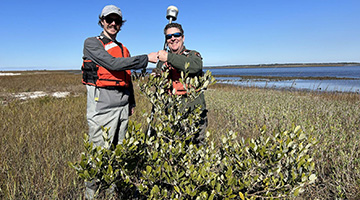UNF biologist helps discover mangrove trees in Georgia farther north than ever recorded
 Dr. Scott F. Jones, an assistant professor of biology at the University of North Florida, recently helped to discover mangrove trees in southern Georgia.
Dr. Scott F. Jones, an assistant professor of biology at the University of North Florida, recently helped to discover mangrove trees in southern Georgia.
The discovery happened in January after a journalist with Scientific American contacted William ‘Ches’ Vervaeke, a coastal ecologist with the National Park Service’s Southeast Coast Inventory and Monitoring Network, for a story he was writing about the northernmost mangroves and the scientists studying them. Vervaeke and Ilka ‘Candy’ Feller, an ecologist with Smithsonian Environmental Research Center, had been studying the northernmost mangrove trees in the U.S. for several years. Vervaeke contacted Jones because of his previous research with mangroves.
Jones, Vervaeke, and the journalist headed north to search for the mangroves. The group went for a boat ride to the area near the south side of Amelia Island where they believed the northernmost mangrove to be and realized mangroves were plentiful in the area.
The group kept moving north until they found the new northernmost mangrove trees, a small group of both red and black mangroves in the marsh near Cumberland Island, just north of the Florida border.
The team documented mangroves farther north than previously recorded in the literature; black mangroves 20 kilometers farther north and red mangroves more than 80 kilometers farther north.
Mangroves are tropical plants that typically die when temperatures are below freezing and are more common in coastal wetlands south of Daytona Beach. The mangrove range has expanded northward in recent years, a result of decades without a lethal freeze event.
“Climate change is a big driver of the expansion, but there are a lot of other factors involved, including the timing of storm events that bring mangroves up the coast,” Jones said. “In the long term, mangroves are going to keep moving up. With a warmer planet, and provided the plants can get to an area, that will happen.”
Jones is closely studying the mangroves in Georgia as well as Florida and hopes to learn more about how this tropical plant is going to impact the resilience of the region’s coastal wetlands.
